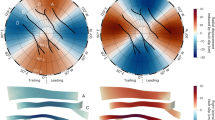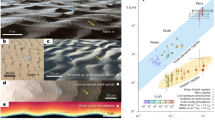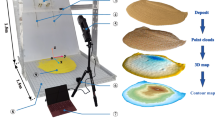Abstract
MANY large impact and explosion craters exhibit coherently overturned flaps in the form of ejecta blankets1–7 in which the pre-existing stratigraphy of the cratered ground is preserved in detail, but inverted. Sequential ejection of material into ballistic trajectories could produce a coarsely graded inversion of the material, but would not retain detailed stratigraphic coherence. The field evidence from fully excavated craters3–7 shows that even totally incompetent strata composed of free flowing sand may be traced continuously through a hinge region below the crater rim outwards to at least three times the crater rim radius. The strata retain their integrity and relative position despite being reduced by stretching from an original thickness of some tens of centimetres to less than a centimetre at the extreme limit of coherent overturning. Figures 1 and 2, a photograph and a stratigraphic plot3 of the hinge region of the Prairie Flat crater at the Defence Research Establishment, Suffield, illustrate the phenomenon. Similar examples are given in the reports of the excavation3–4. The effect was present in all the Suffield trials, and was inconsistent with a free flight mechanism in which discrete elements of sand and clay would follow independent trajectories. However, in very small scale experiments in sand8, which would be most likely to exhibit a free flight phenomenon, the coherence in the overturned flap increased markedly when the sand was saturated with water, as compared to the case with dry sand. In this note I suggest that such coherent overturning may be produced by a wave of hydrodynamic type, which becomes a ‘plunging breaker’ of the type described by Longuet–Higgins and Cokelet9. Evidence to support this suggestion is given below, and consequences of the mode of formation are predicted and compared with the field data.
This is a preview of subscription content, access via your institution
Access options
Subscribe to this journal
Receive 51 print issues and online access
$199.00 per year
only $3.90 per issue
Buy this article
- Purchase on Springer Link
- Instant access to full article PDF
Prices may be subject to local taxes which are calculated during checkout
Similar content being viewed by others
References
Shoemaker, E. M. Int. geol. Congr. XXI Sess. Rep. SV111 (1960).
French, B. M. Sudbury Structure (Goddard Space Flight Centre Rep. X-641-67 1967).
Jones, G. H. S., Diehl, C. H. H., Pinnel, J. H. & Briosi, G. K. Prairie Flat Crater and Ejecta Study (DASA Rep. POR 2155, 1970).
Jones, G. H. S. Morphology of Central Uplift Craters (Suffield Rep. 281, 1976).
Jones, G. H. S. in Impact and Explosion Cratering (Pergamon, New York, 1977).
Roddy, D. J. Proc. 7th Lunar Sci. Conf. (1976).
Roddy, D. J., Ulrich, G. W., Sauer, F. M. & Jones, G. H. S. Proc. 8th Lunar Sci. Conf. (1977).
Piekutowski, A. J. Cratering Mechanisms observed in laboratory scale high explosive experiments (Univ. Dayton, Ohio, Rep. UDRI-TR-76-73, 1976).
Longuet-Higgins, M. S. & Cokelet, E. D. Proc. R. Soc. Lond. A 350 1–26 (1976).
Leet, D. Earth Waves (Harvard University Press, 1950).
Jones, G. H. S. Strong motion Seismic Effects of the Suffield Explosions (Suffield Report 208, 1963).
Jones, G. H. S., Maureau, G. T. & Cyganik, S. A. J. geophys. Res. 68, 4979–4987 (1963).
Press, F. & Ewing, M. Geophysics 5, 416–430 (1951).
Hasegawa, H. S. Can. J. Earth Sci. 5, 185–198 (1968).
Diehl, C. H. H. & Jones, G. H. S. J. geophys. Res. 70 305–309 (1965).
Sauer, F. M. Operation Prairie Flat Symp. Rep. 284–300 (DASA 2377-1, 1970).
Cokelet, E. D. Nature 267, 769–774 (1977).
Price, N. J. J. geol. Soc., Lond. 131, 553–575 (1975).
Carr, M. H. et al. J. geophys. Res. 82, 4056–4065 (1977).
Chao, E. C. T. & Minkin, J. Impact and Explosion Cratering (Pergamon, New York, 1977).
Author information
Authors and Affiliations
Rights and permissions
About this article
Cite this article
JONES, G. Coherently overturned flaps surrounding craters. Nature 273, 211–213 (1978). https://doi.org/10.1038/273211b0
Received:
Accepted:
Issue Date:
DOI: https://doi.org/10.1038/273211b0
This article is cited by
-
Evidence for a large Paleozoic Impact Crater Strewn Field in the Rocky Mountains
Scientific Reports (2018)
Comments
By submitting a comment you agree to abide by our Terms and Community Guidelines. If you find something abusive or that does not comply with our terms or guidelines please flag it as inappropriate.



